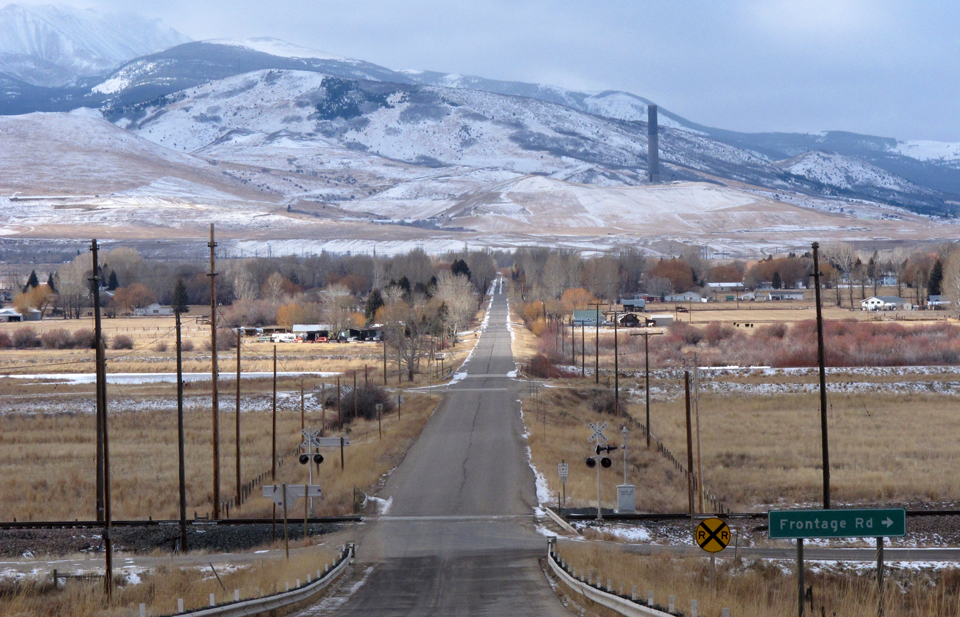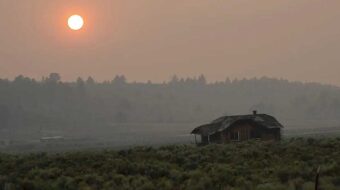
Amongst the rolling hills jaggedly cutting through the horizon of southwest Montana, the Anaconda Range, known informally as the “Pintlers,” creates part of the vast Great Continental Divide, separating the many rivers and watersheds flowing into the Pacific Ocean.
As your eyes span across the horizon, blue skies intertwined with the roughly hued brown terrain, you notice off in the distance an unnatural object reaching up to the sky.
Here in Anaconda, Mont., the brick and cement Anaconda Smokestack (an oversized chimney)—tallest surviving masonry structure in the world—looms ominously.
And for over a century, the small town of Opportunity, founded by the Anaconda Copper Mining Company to show living under a cloud of noxious smoke and ash was safe, was bereft of clean air, land, and water.
For the residents of this town, Opportunity was viewed as taking legal action to force corporate interests, which line the pockets of too many in government, to clean up this now dangerous wasteland.
After over a decade of lower court battles, this David v. Goliath legal case went before the Supreme Court for oral arguments last Tuesday, marking the endgame of this battle. Now the wait is on to see how the highest court will rule: for the 700 rural residents or for Atlantic Richfield Co. (ARCO), a subsidiary of the oil behemoth BP (British Petroleum).
Opportunity and its neighboring town, Crackerville, have asked the Supreme Court to uphold a Montana Supreme Court ruling that federal Superfund law (Comprehensive Environmental Response, Compensation, and Liability Act of 1980), which outlined the the EPA’s role in dealing with hazardous waste sites, does not override this state’s constitutionally guaranteed right to a “clean and healthful environment.”
ARCO, which took over mining operations from the Anaconda Copper Mining Co. way back in 1977, created well-paying jobs in its heyday, but did so at the expense of the earth. It also left residents, most of whom worked at the smelter stack, shocked when operations ceased completely in November 1980—eliminating over 1,000 jobs. Since then, Opportunity’s fight against ARCO has outlived some of its residents, and those who remain continue to piece together the amount of environmental damage the mining did.
The main point, now before the court, deals with arsenic poisoning. Residents shared stories of mass sickness and death among livestock, areas where grass wouldn’t grow, and a spike in the rate of cancer.
The residents’ lawsuit demands ARCO reduce the arsenic levels in the soil through the communities to pre-contamination levels, about 10 times lower than the EPA requirement.
ARCO’s counterargument: “respondents’ soil-excavation plan risks spreading currently contained arsenic everywhere.”
Initially, this case was heard before the Montana State Supreme Court, which found in favor of the residents and ruled compensation for the effects of contamination on the use and value of their land would not be barred by the Superfund law. A total of $60 million in “restoration damages” was ordered to be paid out by ARCO for remediation.
ARCO now argues the demand to restore properties to pre-contamination levels is not possible under the Superfund law and that state courts lack the power and right to review claims challenging federal law.
Of course, Montana’s Supreme Court rejected the company argument, saying “a challenge under that provision must be more than merely requiring ARCO to spend more money to clean up the land or the property owners.” Effectively, the ruling allowed landowners to file claims under state law which would require companies to pay for the cleanup of hazardous waste sites even when they’re already working with the federal government to clean up the area.
During last week’s oral arguments, ARCO lawyer Lisa Blatt framed the issue as a matter of whether “hundreds of thousands of landowners would be able to implement their piecemeal hazardous waste cleanups.”
“It’s profoundly wrong,” Blatt said before the justices, “to assume that it is always better to remove hazardous waste than to leave it in place, and the EPA—rather than ‘jurors on an ad hoc basis’—should be responsible for evaluating the risks of leaving such waste where it is.”
Following a flurry of questions, Justice Elena Kagan said the “sensible solution” would be to have only the EPA responsible for environmental clean-ups, but that Congress gave states a “significant role” when it came to imposing additional requirements.
“What if the Montana legislature believed a lower level of arsenic in the soil would be better?” asked Kagan.

“No,” said Blatt. “Otherwise, independent warring cleanups would utterly destroy the EPA’s whole design.”
We should note that the federal government has filed a brief supporting ARCO’s claim.
Joseph Palmore, on behalf of the residents, argued that the justices should not give the EPA sole responsibility to control the “landowners’ ability to remove even a shovel of dirt from the own yards,” and dismissed any claims that landowners’ remedial efforts “might interfere with the EPA’s plan,” telling justices that “literally nothing has been done” on 95% of the land in question.
Chief Justice John Roberts resisted Palmore’s argument by pointing out nothing had been done because the EPA was concerned about the effects a cleanup would have on local groundwater. Palmore pushed back, saying the remedy for groundwater was found by the EPA to be “technically impractical,” which meant “it was just too expensive.”
Palmore closed his argument by bemoaning that under such a rule, with sole control being held by the EPA, landowners would need to go to the federal government for permission even if they “wanted to dig out space in their yard for a child’s sandbox.”
“There is no evidence Congress intended to give the EPA that kind of vast control forever,” he concluded.
For now, based on the justice’s questions and statements, it would seem they are leaning, ever so slightly, in support of ARCO, if for no other reason but to maintain some semblance of order between states, the federal government, and the EPA.
Click here for an audio recording of the oral arguments in Atlantic Richfield Co v. Christian.












Comments